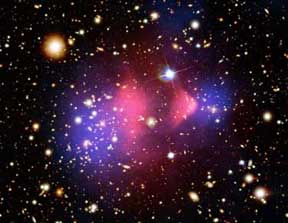Dark matter
is the greatest enigma in physics, astronomy, and cosmology. Recently,
some new possible sightings were reported and a remarkable new
technique, based on DNA, has been proposed.
Starting 80
years ago, scientists began seeing hints of vast clouds of invisible
matter surrounding galaxies and galaxy clusters. This so-called dark
matter is elusive and nearly inert. It is not made of normal atoms nor
normal particles; it emits no light and casts no shadow, but exerts a
dominating gravitational force on all the normal matter we do see.
The Bullet
Cluster reveals much about dark matter. We see below the aftermath of
the collision of two galaxy clusters containing 1000 trillion stars. The
two purple halos are dark matter, whose presence is inferred from its
gravitational impact. Each halo is undisturbed, demonstrating that
dark matter doesn’t interact with galaxies, with ionized gas (the pink
clouds), or even with the other dark matter halo.

In the last
decade, NASA’s WMAP satellite firmly established that there is 5 times
more dark matter than normal matter in our universe.
The leading
guess, and without any direct evidence this truly is a guess, is that
dark matter consists of, as yet undetected, weakly interacting, massive
particles (“WIMPs”). WIMPs are thought to be their own antiparticles (as
are photons), hence if two collide they can annihilate.
For several
decades, experimental physicists have searched for WIMPs, with little
success. At least three experiments claim to have seen hints of WIMPs,
while at least three others failed to confirm their findings.
Two new possible sightings have just been reported, but it’s still iffy.
About 18
months ago, the Alpha Magnetic Spectrometer (AMS) was mounted on the
exterior of the International Space Station, at a cost of $2 billion.
The AMS analyzes cosmic rays, measuring the energy, electric charge, and
type of each particle. Of special interest are positrons, the
antimatter version of the electron. (A normal atom has a tiny nucleus
containing protons and neutrons, surrounded by a much larger cloud of
electrons.) The AMS detected an unusually large number of positrons at
energies corresponding to masses that span the range from a carbon atom
to a uranium atom. The AMS research team suggests the excess positrons
come from WIMP annihilations. Maybe. But since the annihilations weren’t
observed, the evidence is indirect. Scientists will have to be
convinced that no other cosmic phenomena could have created these
positrons.
While some
search in outer space, others hunt in old mines, a mile underground. The
Cryogenic Dark Matter Search (“CDMS”) group reported three possible
events: germanium nuclei recoiling sharply, as if from a collision with
an unseen, heavy particle. Again, the purported WIMP interaction is not
directly observed. Only the slight energy of a single recoiling nucleus
is detected. CDMS will continue collecting data, and must convince other
scientists that these small energy signals don’t come from any
conventional source.
Meanwhile, a
team, including astrophysicist Katherine Freese from the University of
Michigan and geneticist George Church from Harvard, have proposed a
remarkably novel approach. They plan to construct a WIMP detector
consisting of trillions of strands of DNA and thin gold sheets. Each DNA
strand would have the same genetic code and would be 10,000 nucleotides
long. Each strand hangs vertically, with one end attached to a
horizontal gold sheet. The DNA strands will be spaced 1 nanometer (a
billionth of a meter) apart. That spacing is about 100,000 times smaller
than the diameter of an average human hair.
The
detection scheme is ingenious. An incoming WIMP will occasionally hit a
gold nucleus and knock it downward out of the sheet, as sketched below.
The gold nucleus, being heavy and ionized, severs DNA strands as it
passes through the detector. (They plan to use single-stranded DNA,
which is more fragile.) The severed DNA pieces drop to a collector, and
are analyzed to determine the length of each piece to a precision of 1
nanometer. Measuring the gold nuclei trajectories reveals the directions
of the incoming WIMPs, as never before determined.

This
detection system is planned to have 10,000 trillion resolution elements,
called “voxels.” The team claims they will be able to determine exactly
which voxels each gold nucleus traverses. That’s 1000 times greater
precision than any conventional device.
Wonderful
progress is sometimes achieved when scientists from two apparently
unrelated fields join forces. Such was the case when particle physicists
and cosmologists began collaborating.
We think
dark matter completely encircles us. As the Sun orbits the Milky Way, we
should be moving through an ocean of WIMPs, or equivalently, a current
of WIMPs should be flowing by us. And as Earth orbits the Sun, the WIMP
current would be flowing by Earth at different speeds depending on the
time of year; one month we would be heading into the current, and 6
months later we would be heading the opposite way. Thus, the WIMP
signals should vary throughout the calendar year, which helps separate
that signal from the background of conventional interactions, such as
cosmic ray impacts. All this assumes we have some understanding of dark
matter.
Hunters of
the dark side of our universe are enthusiastic about finally catching
WIMPs within the next few years. May the force be with them.
Best Regards,
Robert
May 29, 2013
Note: Previous newsletters can be found on my website.
|